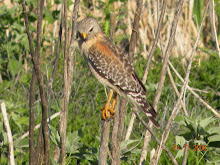

The Cattle Egret did not exist outside of Africa until the late 19th century. They likely flew from Africa to South America and since have extended their range through Florida and then further north and west.
- They have been observed along side the runways of airports waiting for airplanes to pass and blow insects out of the grass. They also follow farm equipment to catch insects that are disturbed.
- It has been estimated that Cattle Egrets are able to gather 50% more food and use only two-thirds as much energy when they feed in association with livestock as opposed to feeding alone.
- A group of cattle egrets are collectively known as a "stampede" of egrets.







